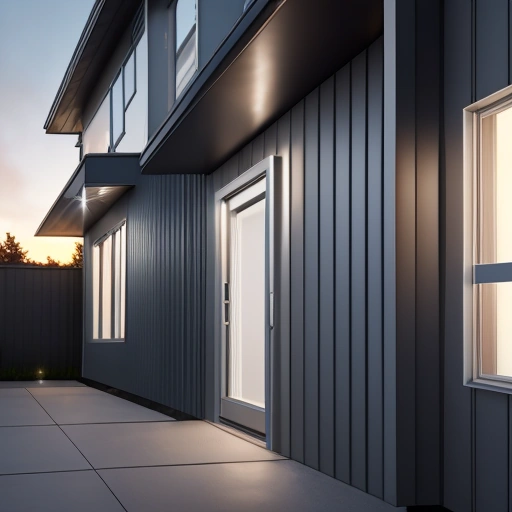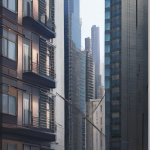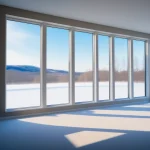The Pros and Cons of Metal Siding: Is It the Right Choice for Your Home’s Exterior?
Metal Siding: A Lasting Shield or a Costly Compromise?
In the realm of home improvement, few decisions carry as much weight as selecting the right siding. It’s the armor that protects your dwelling from the elements, a canvas that paints its aesthetic identity, and an investment that resonates with long-term value. Among the myriad of siding options available, metal siding stands out as a contender with a unique blend of durability, style, and sustainability. But is it the right choice for you? This article delves into the multifaceted world of metal siding, dissecting its advantages and disadvantages to empower you with the knowledge needed to make an informed decision.
We’ll explore the nuances of metal siding, from the robust protection it offers against harsh weather to its increasingly diverse aesthetic appeal, and help you weigh these factors against potential drawbacks such as siding costs and energy efficiency considerations. Metal siding, primarily available as aluminum siding or steel siding, has evolved significantly from its utilitarian origins. No longer relegated to industrial buildings or mid-century modern homes, advancements in manufacturing and coating technologies have broadened its application across diverse architectural styles.
Consider, for example, the rise of vertical metal siding panels mimicking the clean lines of contemporary designs, or the textured finishes that emulate the warmth and character of wood. These innovations provide homeowners with unprecedented design flexibility, allowing them to achieve a desired aesthetic without compromising on the inherent benefits of metal. Understanding these advancements is crucial when evaluating metal siding as a viable option for your home exterior. Choosing the right siding also involves a careful consideration of long-term costs and maintenance.
While the initial siding installation cost for metal may be higher than some alternatives like vinyl, its exceptional siding durability often translates to significant savings over time. Metal siding is inherently resistant to common problems such as rot, insect infestation, and fire damage, reducing the need for frequent repairs or replacements. Furthermore, the low siding maintenance requirements – typically involving only occasional cleaning – free up valuable time and resources. By factoring in these long-term benefits, homeowners can gain a more accurate understanding of the true cost-effectiveness of metal siding. Ultimately, the decision hinges on balancing upfront investment with the promise of enduring performance and aesthetic appeal.
Unmatched Durability and Longevity
Metal siding distinguishes itself with an exceptional lifespan, a critical factor for homeowners considering long-term home exterior investments. Aluminum siding and steel siding, the predominant choices in the metal siding market, inherently resist common culprits of siding degradation such as rot, wood-boring insects, and fire – vulnerabilities that frequently compromise other siding options like wood or engineered wood composites. When properly installed by qualified professionals and diligently maintained, metal siding can effortlessly endure for 50 years or more, demonstrably surpassing the longevity of vinyl and even fiber cement alternatives.
The enduring appeal of metal siding is evident in numerous mid-century modern residences that proudly showcase their original metal cladding, a testament to its resilience and timeless aesthetic. Delving deeper into the durability of metal siding reveals nuanced differences between aluminum and steel. Steel siding, particularly thicker gauges, offers superior impact resistance, making it an ideal choice for regions prone to hailstorms or high winds that could cause dents or punctures. Aluminum, while lighter and more corrosion-resistant, may be more susceptible to denting, though advancements in alloys and manufacturing processes have significantly improved its overall durability.
Homeowners should carefully evaluate their local climate and potential environmental stressors when selecting between aluminum and steel siding options, weighing the trade-offs between weight, strength, and corrosion resistance. Understanding these nuances is key to maximizing the lifespan and performance of their chosen metal siding. The longevity of metal siding also translates to substantial long-term savings. While the initial siding costs may be higher compared to some alternatives, the extended lifespan and reduced need for frequent repairs or replacements ultimately contribute to a lower total cost of ownership.
Unlike wood siding, which requires periodic painting or staining to prevent rot and decay, metal siding boasts a relatively low-maintenance profile, further minimizing expenses over time. This combination of exceptional durability and minimal upkeep makes metal siding a financially sound investment for homeowners seeking a reliable and long-lasting home exterior solution. Furthermore, the inherent recyclability of metal adds an eco-friendly dimension to its long-term value, potentially reducing disposal costs at the end of its service life.
Superior Weather Resistance and Fire Protection
Metal siding, especially steel siding, stands as a formidable guardian against the whims of nature, offering homeowners unparalleled protection from the elements. Its inherent strength allows it to shrug off high winds, endure heavy snow loads that would buckle lesser materials, and even resist the impact of hail without succumbing to significant damage. This resilience makes metal siding a particularly attractive siding option in regions where severe weather events are commonplace. For instance, in areas frequently battered by hurricanes or blizzards, the peace of mind afforded by metal’s robust defense is a significant selling point.
The superior weather resistance directly correlates with long-term savings, as homeowners avoid the frequent repairs and replacements often associated with less durable home exterior materials. Beyond its ability to withstand physical assaults, metal siding provides a crucial layer of fire protection. Unlike wood or vinyl, metal is non-combustible, meaning it won’t contribute to the spread of flames in the event of a fire. This is particularly important in areas prone to wildfires, where embers can travel long distances and ignite vulnerable siding materials.
Consider the devastating wildfires in California and other western states; homes clad in metal siding have a significantly higher chance of survival. While no siding material is entirely impervious to damage from intense heat, metal offers a robust barrier, potentially buying valuable time for firefighters to arrive and contain the blaze. This inherent fire resistance can also translate to lower insurance premiums for homeowners. Furthermore, advancements in metal siding technology have enhanced its performance in terms of both weather resistance and energy efficiency.
Modern aluminum siding and steel siding options often incorporate specialized coatings that improve resistance to corrosion, fading, and even impact damage. These coatings, coupled with proper siding installation techniques, can significantly extend the lifespan of the siding and maintain its aesthetic appeal for decades. Additionally, insulated metal siding products are now available, which combine the durability of metal with the energy-saving benefits of insulation. These insulated options help to reduce heat transfer, keeping homes cooler in the summer and warmer in the winter, ultimately lowering energy bills and improving overall comfort. When evaluating siding costs, it’s crucial to consider these long-term benefits and the potential return on investment.
Long-Term Cost-Effectiveness and Return on Investment
While the upfront investment for metal siding, particularly steel siding, may exceed that of vinyl or fiber cement, its long-term cost-effectiveness often makes it a savvy financial decision for homeowners. The superior siding durability of metal directly translates to fewer instances of repair or complete siding replacement, events that can significantly strain a homeowner’s budget. For example, a homeowner in a region prone to hail might find that while their neighbor with vinyl siding is facing costly repairs after a hailstorm, their metal siding remains unscathed, saving them thousands.
Beyond just impact resistance, metal’s resistance to rot and pests further minimizes maintenance costs, freeing up funds for other home improvement projects. Furthermore, the recyclability of metal siding presents an often-overlooked financial benefit. When it eventually reaches the end of its lifespan – decades down the line – metal can be recycled, potentially yielding some return on the initial investment and reducing disposal fees. This contrasts with other siding options that often end up in landfills, contributing to environmental concerns and potentially incurring disposal costs.
Considering the growing emphasis on sustainable building practices, the eco-friendly nature of metal siding can also subtly increase a home’s resale value, appealing to environmentally conscious buyers. This aspect of ‘green’ value adds another layer to the return on investment calculation. However, a comprehensive cost analysis requires careful consideration of siding installation expenses. Metal siding installation typically demands specialized tools and expertise, making professional installation almost a necessity. This can increase the initial project cost compared to DIY-friendly siding options like vinyl.
It’s crucial to obtain multiple quotes from reputable contractors experienced in metal siding installation to ensure a competitive price and avoid potential pitfalls associated with inexperienced installers. Factors such as the complexity of the home exterior, the type of metal siding chosen (aluminum siding versus steel siding, for example), and any necessary modifications to the existing structure will all influence the final installation cost. Weighing these factors carefully will provide a more accurate picture of the true long-term cost benefits of metal siding.
Modern Aesthetics and Design Versatility
Modern metal siding has shattered preconceived notions of cold, industrial aesthetics, offering homeowners unprecedented design versatility to complement any home exterior. No longer limited to basic panels, metal siding now encompasses a vast spectrum of colors, styles, and textures, providing a wealth of siding options. From the sleek, minimalist lines of contemporary aluminum siding, perfect for modern architectural designs, to steel siding meticulously crafted to mimic the warm, rustic charm of wood-look finishes for a more traditional aesthetic, there’s a metal siding solution to suit virtually any taste and architectural vision.
Moreover, the ability to paint or apply specialized coatings to metal siding further expands the customization possibilities, allowing homeowners to achieve a truly unique and personalized look. The design flexibility extends beyond mere aesthetics; it also impacts the perceived value and curb appeal of a home. For instance, vertical metal siding can create an illusion of height, making a smaller house appear more substantial. The choice of color also plays a crucial role; lighter colors can reflect sunlight and reduce energy costs, while darker hues can add drama and sophistication.
Furthermore, different textures, such as ribbed or corrugated metal siding, can add visual interest and depth to the home’s exterior. By carefully considering these design elements, homeowners can leverage metal siding to enhance their property’s overall aesthetic and increase its market value. This level of design freedom directly addresses a key concern for homeowners undertaking home improvement projects: achieving a personalized and visually appealing result. While metal siding offers exceptional design versatility, it’s crucial to consider the surrounding environment and architectural context.
A sleek, modern metal siding might look stunning in an urban setting but could feel out of place in a rural, heavily wooded area. Similarly, the choice of color should complement the existing landscape and architectural style of neighboring homes. Working with an experienced exterior designer or siding installation professional can help homeowners navigate these considerations and select the metal siding options that best suit their individual needs and preferences. Ultimately, the goal is to create a cohesive and visually appealing home exterior that reflects the homeowner’s personal style while harmonizing with the surrounding environment. This holistic approach ensures that the investment in metal siding not only enhances the home’s durability and value but also its aesthetic appeal.
Relatively Low Maintenance Requirements
Metal siding distinguishes itself with relatively low maintenance demands compared to materials like wood or even fiber cement. The absence of a need for periodic painting or staining is a significant advantage, translating to long-term savings and reduced homeowner effort. Routine cleaning, typically achievable with a simple washdown using soap and water, is usually sufficient to maintain its aesthetic appeal. This ease of care makes metal siding an attractive option for homeowners seeking a durable and hassle-free home exterior.
When evaluating siding options, the reduced siding maintenance associated with metal is a compelling factor to consider alongside siding costs and siding durability. However, the resilience of metal siding doesn’t render it immune to all forms of wear and tear. Scratches and dents, while not compromising the siding’s structural integrity, can be more noticeable on metal than on some other siding materials, potentially impacting the home’s curb appeal. Addressing these blemishes may require professional attention, particularly for achieving a seamless repair or color match.
Furthermore, the choice of finish plays a crucial role; some types of metal siding, especially those with darker hues or lower-quality coatings, can be prone to fading over time, particularly in regions with intense sun exposure. This underscores the importance of selecting high-quality metal siding products with fade-resistant finishes to ensure long-term aesthetic satisfaction. Beyond surface imperfections, it’s worth noting that while metal siding is generally resistant to moisture, proper siding installation is critical to prevent potential issues.
Gaps or improperly sealed seams can allow water to penetrate behind the siding, leading to corrosion or damage to the underlying structure. Regular inspections of the siding, particularly around windows, doors, and corners, can help identify and address any potential problems early on, preventing more extensive and costly repairs down the line. Furthermore, when considering metal siding, understanding the nuances between aluminum siding and steel siding is crucial, as each material possesses distinct properties that influence its performance and maintenance requirements. While aluminum is lighter and more resistant to corrosion, steel offers greater strength and impact resistance. Ultimately, the optimal choice depends on the specific climate, architectural style, and budget considerations of the home.
Potential Energy Efficiency Concerns
While metal is an excellent reflector of heat, mitigating solar heat gain during summer months, its inherent lack of insulation can be a drawback. Homes clad in standard metal siding, be it aluminum siding or steel siding, can experience increased energy bills if thermal performance isn’t properly addressed. The metal itself readily conducts heat, allowing it to transfer into the home during summer and escape during winter. However, this isn’t an insurmountable problem. A well-considered approach to insulation can significantly enhance energy efficiency, making metal siding a viable option even in climates with extreme temperature variations.
It’s crucial to consider the R-value of your insulation to ensure optimal energy efficiency. Look for Energy Star-rated metal siding for enhanced performance, as these products often incorporate features designed to minimize thermal bridging. One effective solution involves installing a continuous layer of rigid foam insulation behind the metal siding during siding installation. This creates a thermal break, preventing heat transfer through the wall assembly. For instance, a homeowner in a colder climate, such as the Midwest, might opt for thicker insulation with a higher R-value to minimize heat loss during winter.
Conversely, someone in a hot, sunny climate like Arizona might prioritize reflective insulation to bounce radiant heat away from the home exterior. Another increasingly popular siding option is insulated metal siding, which integrates a foam core directly into the siding panel. This simplifies the installation process and provides a consistent layer of insulation across the entire wall surface, further boosting energy savings. Beyond insulation, proper ventilation plays a key role in managing energy efficiency with metal siding.
Ensuring adequate airflow behind the siding helps to prevent moisture buildup and regulate temperature. This is particularly important in humid climates where condensation can lead to corrosion and reduced insulation effectiveness. Consider incorporating a rain screen system, which creates a small gap between the siding and the wall sheathing, allowing for improved ventilation and drainage. Furthermore, selecting lighter colors for your metal siding can also help to reduce heat absorption, contributing to lower cooling costs during the summer. By thoughtfully addressing these factors, homeowners can enjoy the many benefits of metal siding – including its durability and low siding maintenance – without compromising on energy efficiency and managing siding costs effectively.
Making the Informed Decision: Is Metal Siding Right for You?
Metal siding presents a compelling option for homeowners seeking a durable, long-lasting, and aesthetically versatile home exterior. While it may not be the perfect choice for every home or budget, its numerous advantages – particularly its superior weather resistance, fire protection, and relatively low siding maintenance – make it a worthy contender among various siding options. Ultimately, the decision hinges on a careful evaluation of your specific needs, architectural style, and long-term investment goals. Considering factors such as regional climate, aesthetic preferences, and budget constraints will guide you toward the most suitable siding material for your property.
This involves not only comparing the initial siding costs but also projecting the long-term value proposition, encompassing factors like energy efficiency and potential resale value. For those prioritizing longevity and minimal upkeep, metal siding, especially steel siding and aluminum siding, often emerges as a frontrunner. Its inherent resistance to pests, rot, and fire significantly reduces the need for frequent repairs or replacements, translating to substantial savings over the lifespan of the siding. Moreover, the modern advancements in metal siding technology have expanded its aesthetic appeal, offering a diverse range of colors, textures, and profiles to complement various architectural styles.
From sleek, contemporary designs to rustic, wood-look finishes, metal siding provides homeowners with greater design flexibility than ever before. This versatility extends to its compatibility with different types of homes, whether it’s a modern urban dwelling or a traditional suburban residence. However, it’s crucial to acknowledge the potential drawbacks and address them proactively. While metal siding boasts impressive siding durability, its energy efficiency can be a concern if not properly addressed during siding installation. Implementing adequate insulation behind the siding or opting for insulated metal siding products can effectively mitigate heat transfer and reduce energy consumption.
Furthermore, while metal is generally low-maintenance, scratches and dents can be more visible compared to other materials. Therefore, selecting a high-quality finish and implementing preventative measures, such as trimming vegetation away from the siding, can help maintain its pristine appearance. By carefully weighing the pros and cons in light of your specific needs and circumstances, you can determine whether metal siding is the right choice to protect and beautify your home for years to come.


